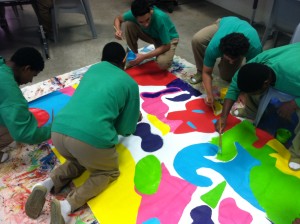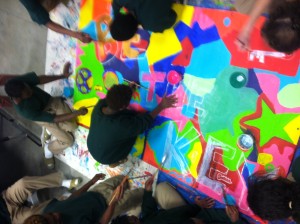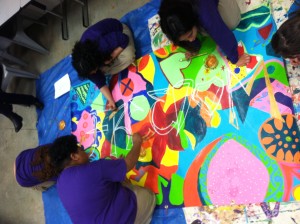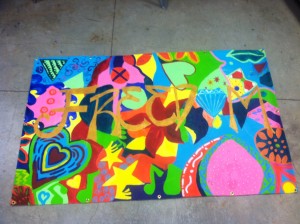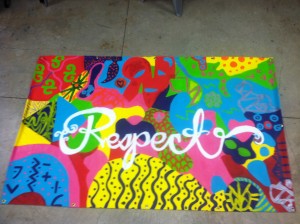Spring Program at San Francisco Juvenile Hall
In February of 2015, Ross Holzman led a 6 week Banners for Peace experience at the San Francisco Juvenile Hall educational center. This was the first time Create Peace Project led a hands-on experience in a detention center. The experience was powerful, challenging, and deeply insightful to watch how four groups (the four classrooms inside the center’s school) worked together in a collaborative arts project.
In a detention center such as this, most of the youth are deeply challenged and emotionally immature. There is a lot of anger and frustration, which results in poor behavior, disrespect and general disregard for authority, guidance or loving support.
It was my job to facilitate a collaborative experience in which the groups of 10-18 students (depending on the group or day) would generate a positive message or slogan that they would agree upon and then paint a 5ft by 8ft canvas together. The first challenge was to get the students to agree upon a single positive message. Everyone had an opinion and at first everyone had something to say about why their idea was the best, or why another students was not interesting to them. The tension was enough to have serious doubt and concern about the outcome of the work.
After the first week, one one group, the girls, were close to agreeing upon what their message was going to be.
The next four Tuesdays were spent painting together. With the canvas laid out on the floor and painted prepared, small groups of 3 or 4 students would come down to the canvas. Each group had selected their color palette, a slightly easier task, since we allocated 8 colors for each group, and they chose their color and began to paint. Now in this setting, with an effort to create a polished work of art, I invite the students to paint simple shapes. This way anyone can do it and their can be no rejections saying ” I’m not an artist.” or “I don’t know how to paint that.” I have learned in my years of working with youth and adults that the easy out for someone is to claim that they are not skilled enough to paint an image that represents something and turns out in a way that they like. So, let’s not paint representational imagery, let’s simply paint form and shape with the colors you like. And so we did.
Each classroom had their leaders and of course those who didn’t want to participate. In one room, one morning, I asked the class who wanted to paint, and no one raised their hand. So I started to ask the boys to join. One boy quickly told me he didn’t like to paint. “Why not?” I replied. “I’m not good at it,” he replied. “Who told you that,” I asked? He didn’t know. So I asked him when the last time he painted, and he said ” In Kindergarten.” “Well, it’s been long enough, come give it a try, and if you don’t like it, you don’t have to continue,” I said. He reluctantly rose from his seat and chose a color to paint with the few others already on the floor. The group shuffled and boys came and when, adding their mark. But that one boy, a 15 year old, never left. He stayed on the canvas for the entire time. As the class came to a close and it was time for the students to move on to their next class, he was the last one painting. I politely asked him to return the paint and prepare for his next class. He was very happy and most certainly satisfied by his craftsmanship. The next week, he was the first to raise his hand when I ask the class the same question at the outset.
I had lots of doubts and frustrations working in this facility at the start. By the end of my time their, the students were into it, they were working calmly and quietly together. Even the older group in the lock-down facility had progressed to completion on their canvas and created a sweet and stylish banner.
I was most definitely surprised and super pleased how these kids, most non-violent, and some violent offenders, over-came their differences, found inspiration and joy in the work, and collaborated to paint, choose a slogan and paint it together over the six weeks I was with them. 